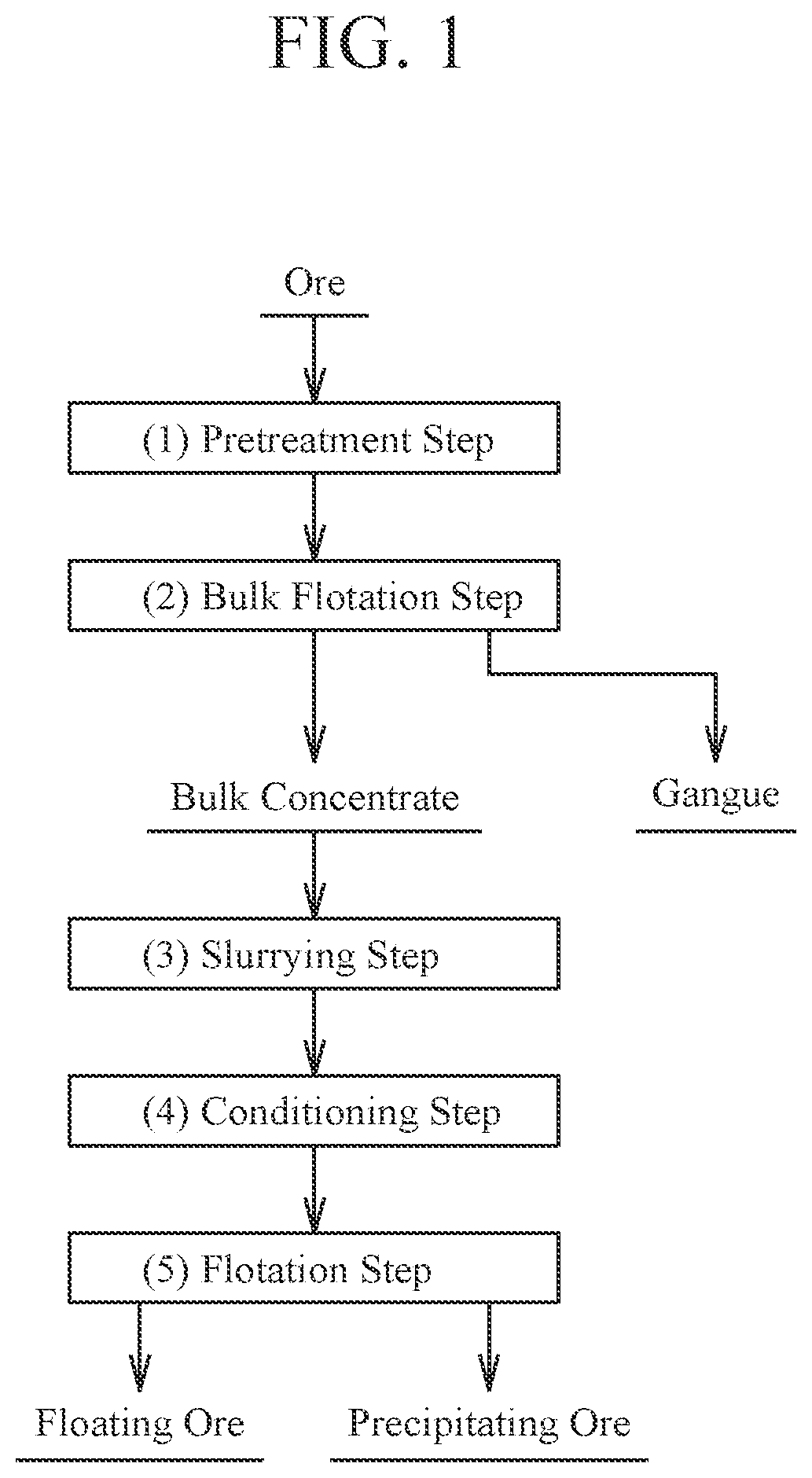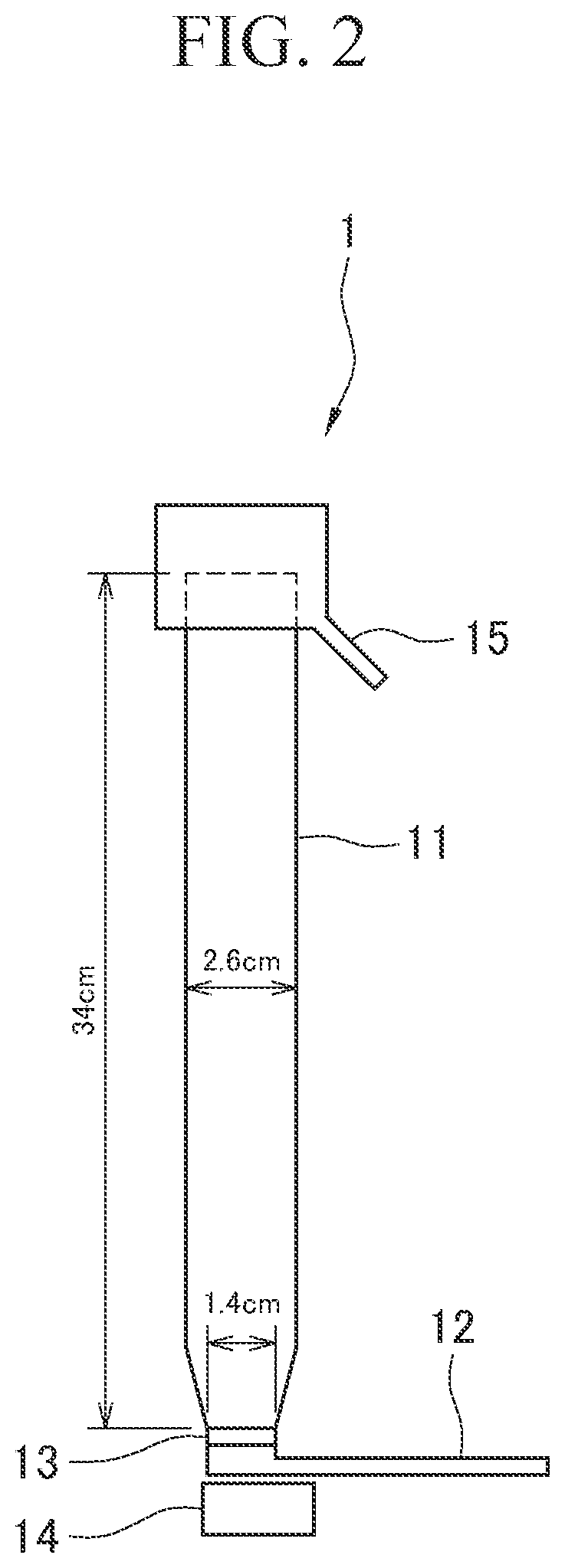Mineral processing method
a technology of mineral processing and flotation, applied in the direction of solid separation, process efficiency improvement, flotation, etc., can solve the problems of difficult to set mineral processing conditions for flotation using sodium hydrosulfide, accelerate corrosion, and adhere to the apparatus of volatilized molybdenum, so as to improve the hydrophilicity of copper minerals, and improve the hydrophilicity between copper minerals
- Summary
- Abstract
- Description
- Claims
- Application Information
AI Technical Summary
Benefits of technology
Problems solved by technology
Method used
Image
Examples
example 1
[0075]The chalcopyrite and the molybdenite, which are commercially available pure minerals, are prepared. The chalcopyrite and the molybdenite were each ground in an agate mortar to be a size of under 38 μm sieve. The chalcopyrite and the molybdenite were mixed at a weight ratio of 1:1 to obtain a concentrate.
[0076]By adding 180 mL of ultrapure water to 0.6 g of the concentrate and stirring it with a magnetic stirrer for two minutes, the mineral slurry was obtained. The mineral slurry has a solid content concentration of approximately 0.3 weight %. The sodium disunite as the depressant and the pine oil as the frothing agent were added to the mineral slurry, and it was stirred by the magnetic stirrer for five minutes. Here, the addition amount of the sodium disulfite was set to 22.3 kg / t relative to a concentrate weight. The addition amount of the pine oil was set to 31.5 kg / t relative to the concentrate weight. The pH of the liquid phase of the mineral slurry was 5, and no pH adjust...
example 2
[0082]The mineral slurry was produced, and the flotation was performed, by the same procedure and conditions as Example 1. However, artificial seawater was used for producing the mineral slurry. The composition of the artificial seawater is shown in Table 2. Consequently, the Newton efficiency was 55.3%.
TABLE 2(Unit: g / L)Cl−Na+SO42−Mg2+Ca2+K+HCO3−Br−17.8710.012.641.180.410.350.140.06
example 3
[0086]A bulk concentrate obtained from an actual ore was prepared. The mineral ratio of the bulk concentrate and the grades of copper and molybdenum are shown in Table 3. Here, the mineral ratio is a result obtained by the MLA analysis, and the grades of copper and molybdenum are results obtained by the chemical analysis.
TABLE 3(Unit: weight %)ChalcopyriteBorniteChalcociteMolybdeniteCu GradeMo Grade51.03.04.28.6224.5
[0087]After adding 370 mL of ultrapure water to 225 g of the bulk concentrate and charging it into a fahrenwald type flotation machine, stirring was performed for one minute as a shear agitation operation. Subsequently, after adding the sodium disulfite to the mineral slurry as the depressant and stirring it for two minutes, the shear agitation was performed for 57 minutes while the gas was further supplied. Subsequently, after further adding 300 mL of ultrapure water (total addition amount 670 mL of ultrapure water) and stirring it for two minutes by the fahrenwald type...
PUM
 Login to View More
Login to View More Abstract
Description
Claims
Application Information
 Login to View More
Login to View More - R&D
- Intellectual Property
- Life Sciences
- Materials
- Tech Scout
- Unparalleled Data Quality
- Higher Quality Content
- 60% Fewer Hallucinations
Browse by: Latest US Patents, China's latest patents, Technical Efficacy Thesaurus, Application Domain, Technology Topic, Popular Technical Reports.
© 2025 PatSnap. All rights reserved.Legal|Privacy policy|Modern Slavery Act Transparency Statement|Sitemap|About US| Contact US: help@patsnap.com


